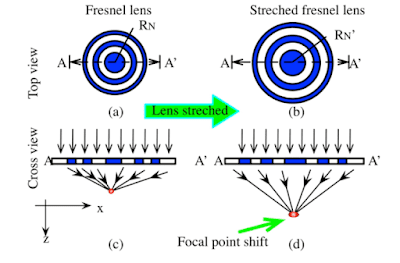Today (July 14, 1827) is the Memorial Day of Augustine-Jean Fresnel, who played a significant role in upholding the theory of the wave of light.

Augustin-Jean Fresnel was born on 10 May 1788 in Brockley, Normandy. His early education was sluggish. He did not know how to read even when he was eight years old. He was the second of four sons of architect Jack Fresnel. His wife, Augustine, you are Mary. In 1790, following the revolution, Brockley became part of the expansion of Eur. The family moved to Mathieu, a hometown of Cherbourg, twice. Madame Fresnel spent 25 years there as a widow. The Fresnel brothers were initially taken home by their mother. The sick Augustine did not want to be depressed. But the famous story he began reading when he was eight years old is controversial. At the age of nine or ten, he did not differ except in his ability to turn tree branches into toy bows and guns. It worked really well.

In 1801, he was sent to the Ecole Centrale in Cain as a company for Augustine Lewis. But Augustine elevated his performance. In late 1804, he was accepted into the Ecole Polytechnic Institute, ranked 17th. In 1808, Ecole Polytechnic excelled in drawing and geometry despite his poor health. In his first year, he won a prize for the solution to the geometric problem posed by Adrian-Marie Legendre.

By exposing Huygens's principle of secondary waves and Young's interference in terms of size, and assuming that the simplest colors are sinusoidal waves, Fresnel gave the first satisfactory explanation of variation by straight edges. Including the first satisfactory wave-based interpretation of vertical diffusion. Part of the same frequency but the addition of sinusoidal functions of different phases is a testament to the fact that forces with different directions are similar. Fresnel explained the nature of polarization, the mechanism of color polarization, and the exchange and reflection coefficients at the interface between two transparent isotropic media, further assuming that light waves are completely inverse.

By generalizing the direction-velocity-polarization relationship for the calcite, he calculated the directions and polarizations of the refractive rays in the doubly-refractive crystals of the biaxial class (Huygens's secondary wave nodes are not axially symmetric). The time between the first publication of his pure-cross-wave hypothesis and the submission of his first correct solution to the biaxial problem was less than a year. Later, he coined linear polarization, circular polarization, and elliptical polarization. He explained how the optical rotation can be understood as the difference in diffusion velocity for both directions of circular polarization. By allowing the reflection coefficient to be complex, the polarity shift due to the total internal reflection exploited in the Fresnel Ramp, the defenders of the established corpuscular theory could not fit his quantitative descriptions of many instances with very few assumptions.

After Maxwell's electromagnetic theory was incorporated in the 1860s by the wave theory of light, some attention was diverted from the magnitude of Fresnel's contribution. In the period between the merger of Fresnel's physics and Maxwell's broad integration, Humphrey Lloyd, a contemporary officer, described Fresnel's cross-wave theory as "the finest fabric that adorned the domain of physics." Research in optics has led to the almost unanimous adoption of the theory of the wave of light. In addition to the rest of Newton's corpuscular theory, he is best known for inventing Fresnel lenses in the late 1830s, using "step" lenses to expand the visibility of lighthouses, and saving countless lives at sea. A simple dioptric (completely refractive) step lens, independently reconstructed by Fresnel, is used in screen magnifiers and capacitor lenses for overhead projectors.
Frenal had a lifetime of tuberculosis. Augustine-Jean Frennell, who played a significant role in upholding the theory of the wave of light, left his world on July 14, 1827, in his 39th year. Although he did not become a public celebrity in his lifetime, he lived long enough to gain the recognition he deserved from his peers. His name is ubiquitous in the Rumford Medal of the Royal Society of London and in the modern terminology of optics and waves.
Source: Wikipedia
Information: Dr. P. Ramesh, Assistant Professor of Physics, Nehru Memorial College, Puthanampatti, Trichy.
Get information like this
https://t.me/joinchat/jpqj3jQLN51kYTk9
https://chat.whatsapp.com/HHC5m0Jz3Ue1E8ilgta0YT
Thanks.
Get information like this
https://t.me/joinchat/jpqj3jQLN51kYTk9
Join Telegram Group.
https://chat.whatsapp.com/HHC5m0Jz3Ue1E8ilgta0YT
Join WhatsApp Group
Thanks.
Also, Read
🛑👍 CSIR-NET Physics Materials and Problems
🛑📕 21 GB and Hundreds of Physics E-Books Collection.
🛑🛥️ How does an Electric Motor work? (DC Motor).
🛑🤹♂️ Science Academies' Summer Research Fellowship Programme for Students and Teachers 2022.
🛑🔌 How does a Transformer work - Working Principle electrical engineering.
🛑🎙️ Transistors Explained - How transistors work.
🛑🔥⚡ How Thermocouples Work - basic working principle.
🛑🔌 Voltage Explained - What is Voltage? Basic electricity potential difference
🛑🔌 What is CURRENT– electric current explained, electricity basics.
Also, Read
🛑👍 CSIR-NET Physics Materials and Problems
🛑📕 21 GB and Hundreds of Physics E-Books Collection.
🛑🛥️ How does an Electric Motor work? (DC Motor).
🛑🤹♂️ Science Academies' Summer Research Fellowship Programme for Students and Teachers 2022.
🛑🔌 How does a Transformer work - Working Principle electrical engineering.
🛑🎙️ Transistors Explained - How transistors work.
🛑🔥⚡ How Thermocouples Work - basic working principle.
🛑🔌 Voltage Explained - What is Voltage? Basic electricity potential difference
🛑🔌 What is CURRENT– electric current explained, electricity basics.






No comments:
Post a Comment